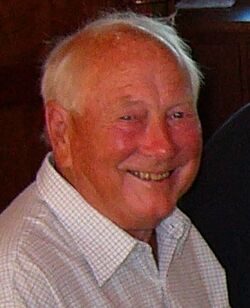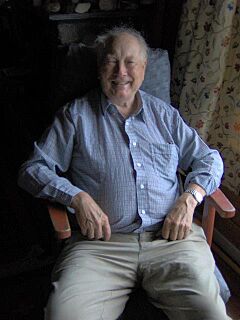Bjørn G. Andersen facts for kids
Quick facts for kids
Bjørn G. Andersen
|
|
|---|---|

Bjørn G. Andersen on the excursion to Greenland 2005.
|
|
| Born |
Bjørn Grothaug Andersen
23 March 1924 |
| Died | 12 January 2012 (aged 87) Asker, Akershus
|
| Nationality | Norwegian |
| Spouse(s) | Astrid E. Kruse Andersen |
| Scientific career | |
| Fields | Quaternary geology, Glaciology |
| Institutions | University of Oslo Yale University University of Bergen |
| Doctoral advisor | Olaf Holtedahl |
Bjørn Grothaug Andersen (born March 23, 1924, in Stavanger, Norway – died January 12, 2012, in Asker, Norway) was a Norwegian professor. He studied Quaternary geology and glaciology. This means he was an expert on the Ice Age and glaciers. His work helped us understand how glaciers shaped the Earth and how our climate changes.
Contents
Life and Career
Bjørn Andersen's father was a gardener. This meant they had a car, which was quite rare back then. They used it to go skiing in winter and fishing in summer. Bjørn loved long skiing trips in the mountains near Stavanger when he was young.
He often crossed a huge, winding pile of rocks called Trollgaren in Ryfylke. Local farmers told him that trolls had built this "fence" of giant boulders. Bjørn wondered how it was really formed. This curiosity about natural wonders made him interested in the Ice Age.
In 1951, he married Astrid E. Kruse Andersen, who was a physiotherapist. Bjørn studied at Yale University in the USA from 1954 to 1956. After that, he became a professor of Quaternary geology.
He taught at the University of Oslo from 1956 to 1970. Then he moved to the University of Bergen from 1970 to 1982. Later, he returned to the University of Oslo and worked there for nine more years. He even led the geology departments in both Oslo and Bergen.
Bjørn taught geology to many students for over 30 years. He was a popular teacher and stayed in touch with some of his students until he passed away in 2012. He continued to be involved in science until late 2011.
Contributions to Ice Age Geology
At the University of Bergen, Bjørn helped build up the study of Quaternary geology. This field looks at the last 2.6 million years of Earth's history, especially the Ice Ages. His students learned a lot from his connections with scientists around the world.
He went on field trips to places like the Antarctic, South America, and New Zealand. But his most important work was understanding how the landscapes of Scandinavia were formed by ice.
Bjørn's first trip to the South Pole was special. At that time, not many Norwegians were exploring the Antarctic. He was only the second Norwegian to visit the South Pole after the famous explorer Roald Amundsen. An American expedition honored his work by naming a mountain cliff the Andersen Escarpment after him.
For his Master's degree, Bjørn studied how glaciers retreated in a part of Norway. He discovered that Trollgaren, the rock formation he wondered about as a boy, was actually a moraine. A moraine is a pile of rocks and dirt left behind by a glacier. He found it formed about 11,000 years ago.
He created new ways to study moraines, including using stereoscopic analysis of aerial photos. This helped him map moraines across most of Norway in the 1950s and 1960s. His PhD work focused on the moraines along Norway's south coast.
Bjørn also found a new area in Rogaland with very old rocks. He collected fossils there, and scientists later discovered a new trilobite species from his collection. They named it Ptychparia anderseni after him.
During his fieldwork, Bjørn developed a method to figure out past climate conditions. He did this by rebuilding how Ice Age glaciers looked. This method is still used by scientists today. He could even estimate how much summer temperatures dropped during the Ice Age.
Mountain Preservation and Hiking
Bjørn Andersen loved walking in the mountains, both for work and fun. As a child, he hiked with his father and brothers. Later, he explored wild mountain areas like Jotunheimen and Rondane with his wife.
As a geologist, he mapped Norway's major mountain regions. He also played a big part in protecting these areas. His work helped create many of Norway's National parks, like Jostedalsbreen and Hardangervidda.
After Retirement
Even after retiring, Bjørn remained a dedicated glaciologist. He joined scientific trips to Chile (1991–1999) and New Zealand (2000–2008). These trips led to many scientific papers, some published in famous journals like Nature and Science.
He also wrote two books about glacial geology. One was about the Ice Age in Norway, called Istider i Norge (2000). The other was an international textbook, The Ice Age World (1997).
In 2005, Bjørn went to Greenland with other scientists. They wanted to measure the ice cover to understand how climate change was affecting it. In 2011, he presented his research from New Zealand at a conference in Switzerland. He also joined an expedition to the Lysefjord in Norway, where he had done his early research.
Honors
- 1956: He received the Reusch Medal for his work on moraines in Southwest Norway.
Selected Publications
Books
- Bjørn G. Andersen and Harold W. Borns Jr., 1997: The Ice Age World: an introduction to quaternary history and research with emphasis on North America and Northern Europe during the last 2.5 million years. This book explains the Ice Age world.
- Bjørn G. Andersen, 2000: Ice age Norway: landscapes formed by ice age glaciers. This book describes how glaciers shaped Norway's landscapes.





